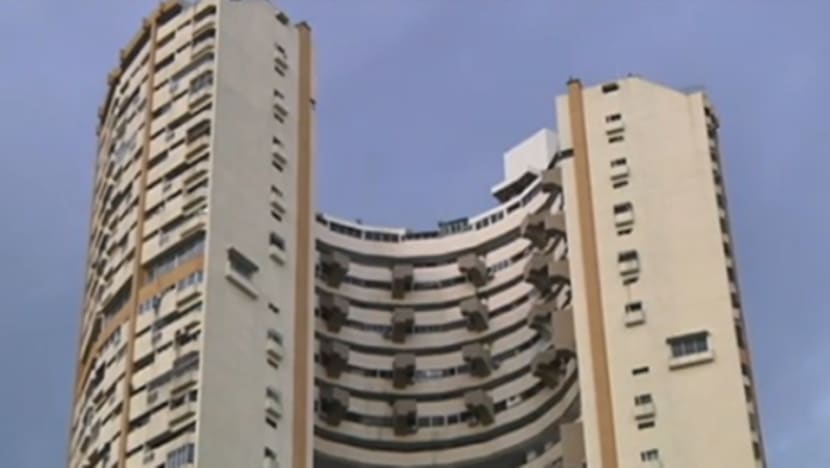commentary Commentary
Commentary: How do we decide which buildings are worth conserving?
Architectural heritage goes beyond what looks aesthetically pleasing – we keep things because they remind us of how we developed as a society, says one observer.

The building, which was built in 1973, was designed by DP Architects. (Photo: ET&Co)
SINGAPORE: The conservation status plans for Golden Mile Complex (GMC) has been extremely well received by the conservation circle.
This is a landmark decision for heritage conservation in Singapore as it opens a new page in our efforts to preserve significant architectural heritage.
Particularly, since GMC is a strata-titled property, the gazetting of this substantial private property for conservation while given enough development incentives is indeed trailblazing locally and even regionally.
As the first project of its kind, we might want to consider the framework in which this decision was made and how the community can embrace the framework objectively.
Conservation is value-based, it is about passing on heritage of significance to future generations. The buildings that are preserved are identity markers of society’s achievements that community in the future can be proud of or debate over.
READ: Golden Mile Complex to be proposed for conservation, incentives will be offered: URA
READ: Commentary: Conserving Golden Mile Complex is a paradigm shift for Singapore architecture
Architecture conservation is primarily a sociocultural endeavour. Historic buildings are conserved for their intrinsic role in the development of the society and community, and not just for the technical or aesthetic value of the architecture.
However, much has to be done to convince the current generation that a rigorous assessment process had been carried out in conservation decisions to ascertain the value of heritage for the community to buy in.

This is fundamental in the conservation process. There are three pillars in value-based conservation assessment recognised internationally: Historical, social and architectural value.
In the case of GMC, a great deal of research and advocacy went on behind the scenes: The Singapore Heritage Society, International Council on Monuments and Sites (ICOMOS) Singapore and International Committee on Documentation and Conservation of Buildings (DoCoMoMo) Singapore had been at the forefront in advocating the conservation of modernist buildings in Singapore.
Likewise, architectural students in NUS and elsewhere had been exploring the conserved and reused future of GMC.
HOW THE GOLDEN MILE COMPLEX WAS DESIGNED
To begin with, all buildings and urban planning are products of the historical and cultural development of a society. Urban and architecture designs reflect the context of the society and contribute to the national history in her development.
In the early 1960s, Singapore went through a difficult time with much political turmoil. However, with independence in 1965, the new nation looked towards an exciting future with a new identity.
READ: Commentary: We mourn the loss of Robinsons because it was a key piece of our childhood
It is in this context that the Government sought a new planning, urban design and architectural vision to usher in the new era of self-confidence and nationhood.
The result was the plan to develop the eastern section of Beach Road into the new commercial, office and residence hub of the country, hence the name Golden Mile.
Bold planning and architectural initiatives were soon put forward to create the modern infrastructure, such as streets in the sky and separate vehicular and pedestrian traffic along the key road.
And GMC was the first multi-purpose complex built as a symbol of progress in the efforts to propel Singapore into a global city, as pointed out by architecture scholar Koon H Wee.

GMC has a historical position in putting into built form the national agenda at the founding stage. Other examples of successful conservations are the former Singapore Conference Hall, People’s Park Complex and the former Subordinate Courts.
But there are also others that slipped through the net – the former National Theatre and the Pearl Bank Apartments are two that come to mind.
HOW DO WE DEFINE SHARED VALUES?
Within the context of the historical development, we should also examine the architectural heritage in how it has been regarded by the society during its lifetime, including current attitudes.
Issues such as identity, shared memory and a sense of belonging, should be examined.
Social value of built heritage has been accorded increasingly important consideration for architectural conservation in recent years.
It is an embodied value that can only be extricated by qualitative studies, including focus group interviews and participatory engagements.
LISTEN: The Singapore property market: Is it changing for good?
I would argue that social value is a crucial yardstick for determining the significance of heritage buildings for conservation.
Because of the position of GMC on Beach Road, initially among rows of shophouses, and later adjacent to HDB estates, and due to its mixed-use design, the building has always been the centre of the community in the neighbourhood.
In recent years when GMC became a Thai community hub, it has taken on another social meaning in Singapore. Society is evolving, there are constant changes and in Singapore, sometimes at break-neck speed.
Conservation is essentially management of change. To preserve the social meaning of GMC and other heritage should be a key objective of architectural conservation.
THE BEAUTY OF BRUTALIST ARCHITECTURE
Architecturally, GMC represents an important example of the international Brutalist style, a movement that flourished between the 1950s and 1970s.
Brutalist buildings, which display structural honesty with exposed raw concrete material, were embraced by many great architects of the 20th century, such as Le Corbusier and Paul Rudolph.
The style is seen as a tour-de-force of the rebirth of societies after the ravages of the Second World War. Because of its quiet monumentality, the style was also chosen for the institutional architecture in some countries after they gained independence from colonial powers.
The elements and architectural language used in this style is also part of the Modernist movement in architecture which connotes modernity and internationalism.
Being part of a small group of Brutalist buildings in Southeast Asia, such as the Olympic Stadium in Phnom Penh (Vann Molyvann 1964), Tanghalang Pambansa in Manila (National Theatre, Leandro Valencia Locsin, 1969) and the Australian High Commission Building in Kuala Lumpur (Joyce Nankivell Associates, 1979), the conservation of GMC will lead efforts in the conservation of these post-war structures.

GMC has a well-articulated form, excellent spatial experience, and relates well to its waterfront location.
As one of the first mixed use development with shopping, office and housing in one mega-block, GMC is also a pioneer in the architectural experimentation with the podium-and-block typology that is now common place in large-scale development in Asian cities.
The architects William Lim, Tay Kheng Soon and Gan Eng Oon of Design Partnership (now known as DP Architects), showed architectural mastery in giving GMC a clarity of forms through the distinctive separation of three functionalities: A large block of shops around a top-lit atrium, an office block with façade emphasizing horizontality and a novel stepped-housing block.
This is an important contribution to architectural form of mixed-use development, both in Singapore and the region.
WHAT NEXT FOR SINGAPORE ARCHITECTURE
GMC has a significant place in Singapore history. The progressive vision of a new country was translated into physical form by three pioneer architects.
Educated in both renowned architectural schools in London and Boston, as well as in the local architectural school, Lim, Tay and Gan played a crucial role in the discourse on urbanism, architecture and culture of the new nation, as well as in serving as a think tank on planning and the built environment consulted by the Government.
The two major landmark projects of the architects, People’s Park Complex (1973) and GMC, embody the aspiration of the architecture practice of “producing an architecture that uplifts the human spirit”.
The impact of their vision and architecture can still be seen in the projects of the practice. This is essentially the historical value of GMC.
READ: Commentary: Retail isn’t dead – look at snaking queues outside Apple stores
Because of its simplicity of form and elements, modernist architecture tend to be least accepted by the public. Many of them might be functional in design and considered too utilitarian and commonplace in appearance.
However, post-war buildings are usually institutional and communal in use, such as schools, hospitals, public housing and commercial buildings.
They are cornerstones of everyday life that built modern Singapore, and should be considered significant elements in our history.
Many young architects in Singapore are very keen to conserve modernist heritage, paying great respect to their architectural values, and are capable of turning GMC and other structures for contemporary use.
The potential of conservation and adaptive reuse of modernist architecture is enormous, thus the current conditions of the buildings should not be a hindrance to their conservation.
The way forward for architecture conservation in Singapore should be a holistic and honest evaluation of our modern heritage that articulates their architectural, historical and social values in light of the formative years of nation building.
This is an issue facing many cities in rapidly developing Asia, but receives very little attention due to the antiquated view of what constitutes heritage.
We should regard GMC as the first of many modernist buildings in Singapore for conservation due to the vigorous social, architectural and historical value assessment.
Singapore can and should lead the region in the conservation of modernist architecture.
Ho Puay Peng is Head, Department of Architecture, NUS School of Design and Environment and the UNESCO Chair Professor in Architectural Heritage Conservation and Management in Asia.














